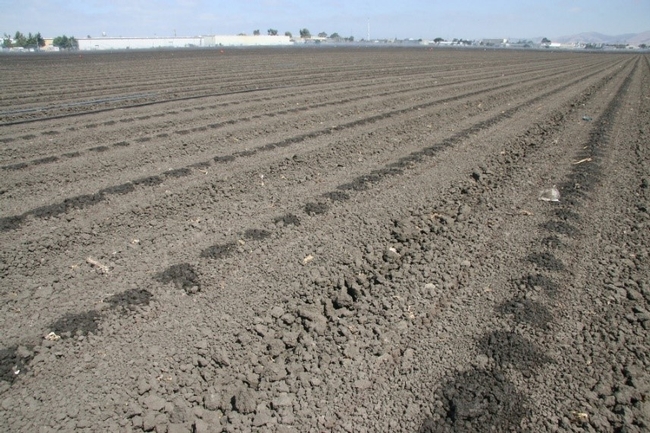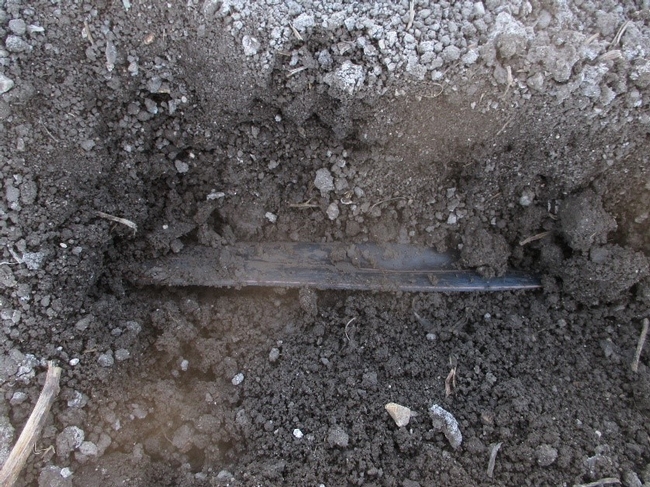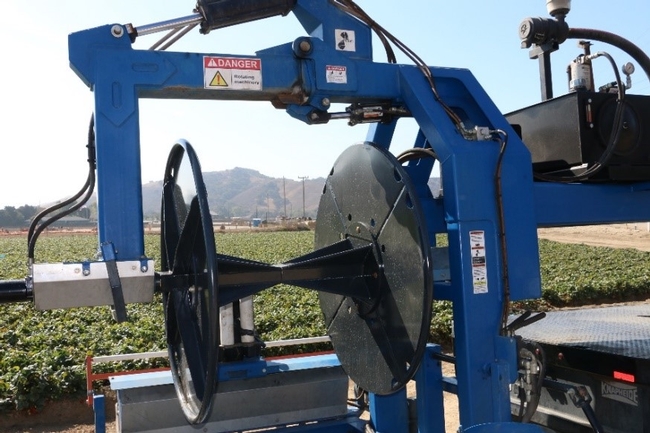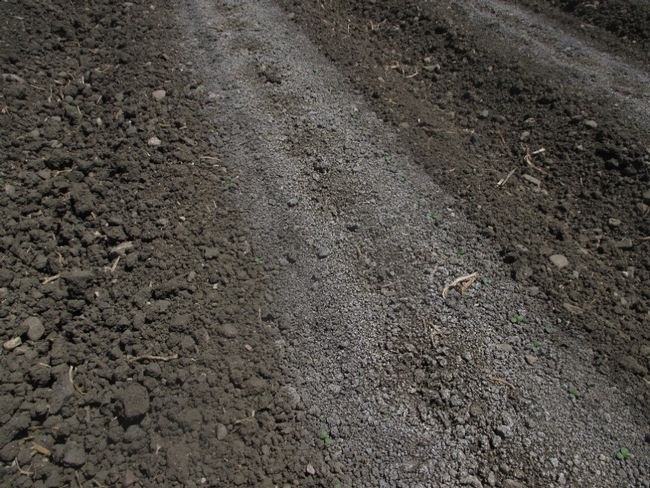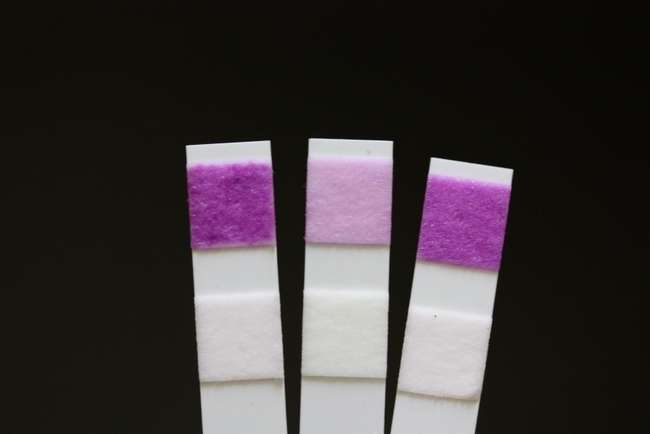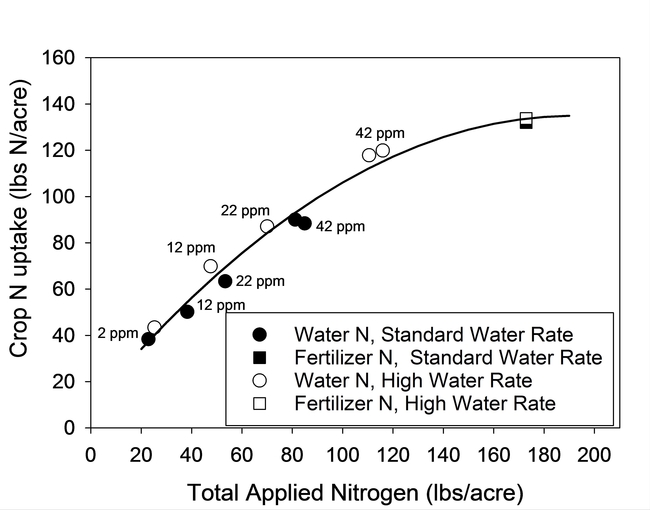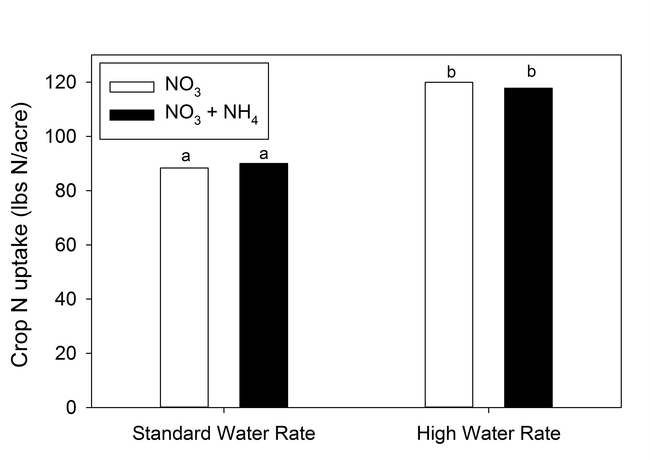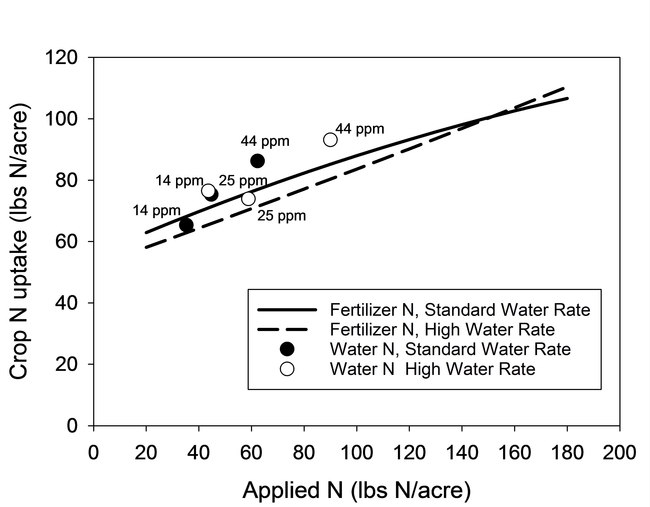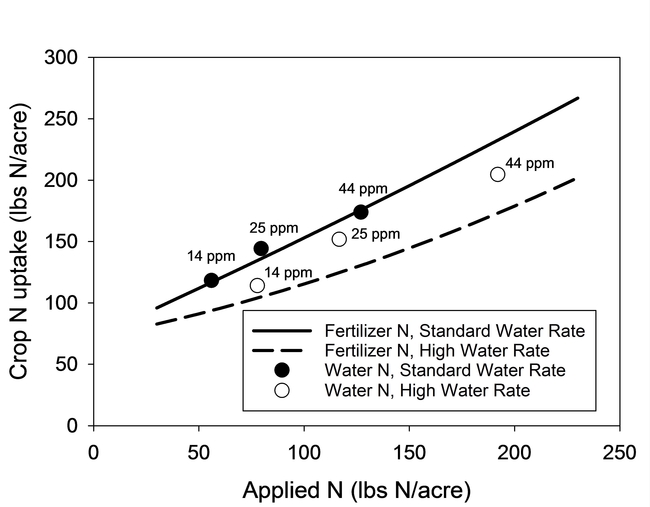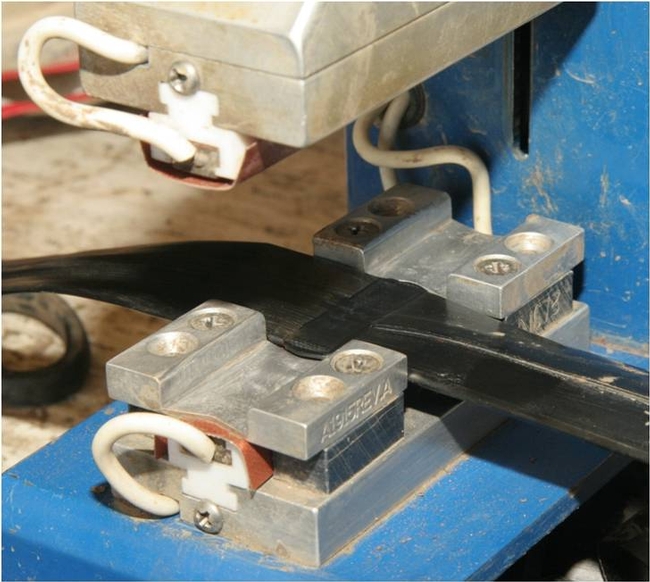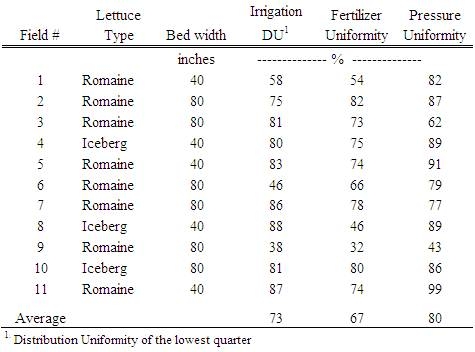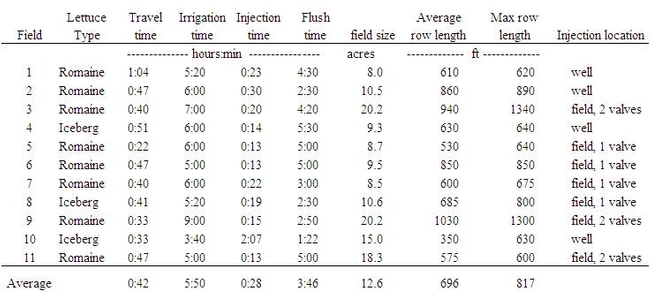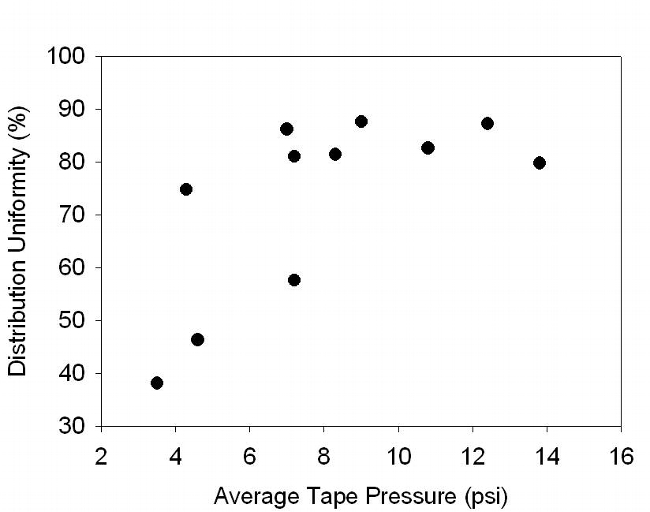- Author: Richard Smith
- Author: Michael Cahn
During the past two years acreage of season-long drip in lettuce has increased rapidly in the Salinas and adjacent valleys. Using drip for the entire crop cycle allows growers to germinate seeded crops with buried tape (Photo 1), and eliminates labor needed for installing and removing sprinklers. The rapid expansion of this irrigation practice is due to 1) reliable thin-walled single-use drip tape which assures high application uniformity for less cost than thick walled tape; 2) Better injection equipment that can uniformly place drip tape 2-3 inches below the soil surface allowing cultivation without damaging the tape (Photo 2), and 3) development of tape removal equipment that saves labor and efficiently bundles the tape for recycling (Photo 3). The use of drip for germinating lettuce often can improve the uniformity of stands and save water by eliminating common problems associated with using sprinklers such as emergence patterns caused by wind and crusting of the soil surface. Drip germination works best on light to medium textured soil types such as sandy loams, gravelly sandy loams, loams, and silt loams (e.g. along the river and on the eastside of the Salinas Valley).
Unlike sprinklers which infiltrate water at the soil surface, water applied by buried drip wicks upward keeping herbicides and fertilizers sprayed on the bed tops close to the soil surface. The upward movement of moisture from buried drip tape and subsequent evaporation of water from the bed top yields a net accumulation of salts (including nitrate) near the soil surface (Photo 4). This upward movement of applied materials benefits the preemergent herbicide, Kerb, which is often pushed too deep in the soil by sprinkler applied water at germination. The amount of wetting of the soil surface provided by drip germination is sufficient to set Kerb and keep it in the zone where weed seeds germinate which improves its effectiveness (for more information on this subject go to: https://ucanr.edu/blogs/blogcore/postdetail.cfm?postnum=30847).
With buried drip, surface-applied fertilizers used as anticrustants or for thinning by automated thinners are not moved deep enough into the soil to be taken up by the lettuce crop during the early season. In one evaluation, we observed that the fertilizers were strongly stratified in the top inch of soil. Soil samples of the top six inches of soil by one-inch increments indicate that the nitrate levels in the top inch of soil are commonly higher than the deeper in the profile due to the upward movement of salts by evaporation mentioned above (Table 1). However, following the application of 20 gallons of 28-0-0-5 for thinning, the levels of mineral nitrogen (ammonium-N and nitrate-N) became extremely high (> 200 ppm NO3-N) and did not decline for the two weeks of the evaluation. In another field evaluation in which nitrogen fertilizer was applied to the soil surface (as an anticrustant (5-20-0) and for thinning (14-0-0-5)) the nitrogen remained in the upper two inches of soil for more than 5 weeks. This nitrogen just below the surface would be unavailable for crop growth because the soil is dry and root growth is minimal.
Table 1. Total mineral nitrogen (ammonium-N + nitrate-N) in the top 6 inches of soil. May 22 – prior to thinning; three subsequent sampling dates following application of 28-0-0-5 fertilizer by an autothinner
Since growers must report the total nitrogen applied to vegetables to the Regional Water Quality Control Board (RWQCB), the nitrogen remaining on the soil surface creates a problem. For instance, a typical application of 20 gallons of 14-0-0-5 contains 29 lbs of nitrogen/acre. This nitrogen is reported to the RWQCB but does not necessarily provide nitrogen for crop growth. More nitrogen would need to be added to keep up with the N demand of the crop. It would be advantageous to use materials in the autothinners that contain no or low amounts of nitrogen.
High levels of nitrogen on the surface also creates a challenge for collecting an accurate soil sample for determining plant-available nitrogen using the nitrate quick test or laboratory analysis. Photo 5 shows the results of three measurements: 1) high levels of nitrate-nitrogen found in the top 2 inches of soil (test strip on the left); 2) moderate amount of nitrate-nitrogen found in the 2 to12 inch layer (top 2 inches scraped off, test strip in the middle); and 3) high levels of nitrate-nitrogen found in the top 12 inches of soil (top 2-inches of soil is not scraped away, test strip on the right). We have always recommended scraping the dry surface soil away before collecting a soil core (see https://ucanr.edu/blogs/blogcore/postdetail.cfm?postnum=4406), however, the extremely high amounts of nitrate-nitrogen in the top 2 inches of drip irrigated fields that are autothinned with a nitrogen fertilizer makes this practices particularly critical in order to not over estimate the amount of plant-available nitrogen in the soil when making critical fertilizer application decisions.
Summary:
- Season-long use of buried drip keeps herbicides and soil applied fertilizers (from anti-crustants and automated thinners) close to the surface due to the water wicking upward.
- Surface applied fertilizers remain in the top 2 inches of soil and are not plant available for much of the season. Ideally, a zero or low nitrogen containing thinning chemical would avoid this issue.
- It is important to scrape away the top two inches of soil when collecting samples for nitrate testing in order to not over estimate the amount of plant-available nitrogen when making fertilizer application decisions.
- Author: Michael Cahn
- Author: Tim Hartz
- Author: Richard Smith
- Author: Laura Murphy
Irrigation water from many wells on the central coast contains a significant amount of nitrate-nitrogen (NO3-N); recycled water from the Monterey Regional Water Pollution Control Agency, the sole water source for approximately 12,000 acres of prime Monterey County farmland, is high in both NO3-N and NH4-N. Growers historically have been reluctant to modify their N fertilization practices on the basis of irrigation water N content because it is unclear how one can reliably calculate the ‘fertilizer value' of this N. This issue has taken on added significance with under the current ‘Ag Order' that was adopted by the Central Coast Region Water Quality Control Board in 2012. The Ag Order requires tier 2 and 3 growers who produce vegetable and berry crops to report the total amount of nitrogen applied to crop land, including N contained in irrigation water. Baseline numbers from the first two years of reporting on the Central Coast clearly showed that a majority of vegetable producers applied significantly more nitrogen than their crops took up.
Water quality regulators would like growers to take proactive steps to reduce nitrogen inputs to their crops. One way many growers could make significant reductions in their use of fertilizer N is by off-setting their nitrogen fertilizer rates by a portion of the N applied through their irrigation water. The term “pump and fertilize” has been used to describe this practice because conceptually a grower is pumping water and using the water as fertilizer for the crop. The benefit for the grower is lower fertilizer costs, and the benefit for the environment is reducing nitrate loading to groundwater.
In the Salinas Valley, the nitrate concentration of water pumped from agricultural wells averages more than 20 ppm N. This N concentration would translate to 37 lbs of N per acre for a lettuce crop receiving 8 inches of irrigation water. A significant number of wells have nitrate-N concentrations in the range of 30 to 50 ppm, and the amount of N that potentially could be applied to crops by irrigating with this water could be as high as 55 to 90 lbs per acre. Since most lettuce crops take up 130 to 150 lbs of N per acre, high nitrate water could substitute for one third to half of the fertilizer N normally needed to produce a crop.
Despite the potential benefits of implementing “pump and fertilize,” adoption by growers has been slow. One reason is due to doubts that the nitrate in irrigation water is completely available to crops. Chemically speaking, nitrate in fertilizer and ground water are exactly the same. Nevertheless, growers are concerned that N concentrations in high nitrate water may still be too low to be absorbed by crop roots. Fertilizer N applications usually boosts the N concentration of the water in soil pores to levels much higher than are found in irrigation water.
Another reason that growers are reluctant to account for the N in irrigation water is because they are uncertain about how much fertilizer credit to take when water is applied to leach salts that build up in the soil. Some growers have also expressed concern that the nitrates significantly increase the salinity of water, making it less beneficial to their crops. Finally, growers who use multiple wells to irrigate their fields have difficulty estimating the average N concentration of the irrigation water applied to their crops.
Research trials
Unfortunately, a limited body of research documents the efficiency of crop uptake of N from irrigation water upon which to base an estimate of ‘fertilizer value' under normal irrigation and N management practices. During the past 3 years we conducted replicated field trials to evaluate how much of the nitrate in irrigation water could be taken up by head lettuce (cv. Telluride) and broccoli (cv. Patron). Crops were seeded in two rows on 40-inch wide beds, and germinated with sprinklers. The only N applied at planting was from an anti-crustant application ranging from 17 to 22 lbs N/acre. Crops were drip irrigated after establishment using water of nitrate concentrations ranging from 2 to 44 ppm N. Water-powered injection pumps were used to enrich all drip applied water to target nitrate concentrations. Injected NO3-N was a blend of Ca(NO3)2 and NaNO3 to maintain the cation balance in the water. These water treatments were compared to an unfertilized control and standard fertilizer treatment (150 and 225 lbs N/acre AN20 for lettuce and broccoli, respectively). In addition, a water treatment dominated by NH4-N was included in the trials to simulate the N composition of recycled water. To observe the interaction of irrigation efficiency and crop nitrogen recovery, each N treatment was evaluated at two rates of applied water: 1. Standard water rate of 110% of crop ET 2. High water rate of 160% to 180% of crop ET, which corresponded to a 40% to 50% leaching fraction.
A second set of field trials directly compared crop N recovery from irrigation water and fertilizer. Irrigation water with concentrations of 14, 25, and 44 ppm NO3-N were compared with fertigation applications of AN20 of seasonal totals equal to 0, 20, 60, and 150 lbs N/acre in lettuce and 0, 40, 80, and 200 lbs N/acre for broccoli.
Treatments in all trials were replicated 4 times and individual plots measured 4 beds × 40 ft. All trials were harvested when the highest fertilizer treatment reached commercial maturity. Above ground fresh and dry biomass yield were evaluated in the center two beds of the plots. Whole plant N content was determined so that crop N uptake could be estimated. Crop N uptake was plotted against N applied in the water and fertilizer N treatments. The amount of N applied in the water treatments was calculated by the equation:
Applied N (lbs/acre) = applied water (inches) × NO3 concentration of water (ppm N) × 0.23
Note, that based on this equation applied N from the water treatments will increase as the amount of water applied and concentration of NO3 in the water increases.
Crop N uptake response to nitrate in water
Results of the lettuce trial demonstrated that the concentration of nitrogen in the irrigation water significantly affected plant size, N content of tissue, biomass yield (data not presented) and confirmed that a significant portion of the N in the irrigation water was taken up by the crop (Fig. 1). The crop was able to utilize concentrations of NO3-N as low as 12 ppm in the irrigation water. Similar results were also observed in the broccoli trial (Fig. 2). As shown by the regression curves fit to the data, crop N uptake from irrigation water increased as the concentration of N in water increased. The fertilizer treatment (square symbols) indicated that crop N uptake would likely level off at high N concentrations.
The N uptake from the water treatments in lettuce was similar for high and standard water rates, indicating that the volume of water applied did not affect the recovery of N (Fig. 1) and that all of the applied water could be credited as having N value for the crop. For broccoli, N uptake was lower under the high water rate (180% ET) than the standard water rate (110% ET). However, the recovery of N from the standard fertilizer treatment was also less under the high water rate (Fig. 2).
Figure 1. N uptake by lettuce from water and fertilizer sources of N at standard (110% ET) and high water rates (160% ET). Symbols represent the mean N uptake of water and fertilizer treatments. N concentration of water treatments is displayed next to the symbols
Figure 2. N uptake by broccoli from water and fertilizer sources of N at standard (110% ET) and high water rates (180% ET). Symbols represent the mean N uptake of water and fertilizer treatments. N concentration of water treatments is displayed next to the symbols.
Nitrate and ammonium sources of N in water
The source of N in the irrigation water (NH4 vs NO3) had no significant effect on N recovery by the crop (Fig. 3). Presumably under normal summer temperatures NH4 would quickly transform to NO3 when added to the soil. Nitrate did boost the salinity of water, but the amount was small: approximately 0.07 dS/m for each 10 ppm increase in Nitrate-N concentration. Hence, water with a 45 ppm NO3-N concentration would have a small boost in electrical conductivity equal to 0.31 dS/m.
Figure 3. N uptake by lettuce from water with nitrate and ammonium sources of N at standard (110% ET) and high water rates (160% ET).
Crop recovery of N from water vs fertilizer
The second set of trials confirmed that crop recovery of N from irrigation water and fertilizer was similar in lettuce (Fig. 4) and in broccoli (Fig. 5). Symbols in both figures represent the mean N uptake response from the water treatments, and the regression curves were fit to the N uptake response to the fertilizer treatments. The observation that crop N uptake of most water treatments was equal to or greater than values represented by the regression line demonstrated that crop recovery of N from irrigation water was equal to or greater than from fertilizer. Similar to the previous trials, crops were able to recover N from water with concentrations of nitrate as low as 14 ppm N. N recovery was similar under high and standard water rates for lettuce but as found in the earlier trial with broccoli, crop N recovery declined for both the fertilizer and the water sources of N under the high water rate (Fig. 5).
Figure 4. N uptake by lettuce from water and fertilizer sources of N at standard (110% ET) and high water rates (170% ET). Regression lines represent N uptake response to fertilizer treatments. Symbols represent average N uptake from water treatments. N concentration of water treatments is displayed next to the symbols.
Figure 5. N uptake by broccoli from water and fertilizer sources of N at standard (110% ET) and high water (180% ET) rates. Regression lines represent N uptake response to fertilizer treatments. Symbols represent average N uptake from water treatments. N concentration of water treatments is displayed next to the symbols.
Implications for reducing N inputs
The results of these field trials demonstrated that N in irrigation water has fertilizer value for both shallow (lettuce) and deep (broccoli) rooted vegetables, even when the N concentration in the water was low (12 to 14 ppm N). The trials also showed that the volume of water applied did not affect the crop recovery rate of N from water more than from fertilizer, suggesting that it is reasonable to credit all the N applied in water as having fertilizer value to the crop. These results were attained under well-managed drip irrigation with a high application uniformity and frequent irrigations so that irrigation volumes were small, which likely minimized leaching losses of any single irrigation event. It is possible that under poor water management or less efficient irrigation methods (eg. furrow), recovery of N would be less than was reported in these trials.
Although the results of these experimental trials confirmed that growers can confidently take credit for background levels of nitrate in the irrigation water, one should still be cautious when implementing this practice. Experimenting on fields where the water source is known to have a consistently high concentration of nitrate but is not excessively high in salts is recommended. Drip provides better control of irrigation volumes than sprinklers and furrow systems, which may minimize excessive leaching, and also offer more opportunities for fertigating N to correct observed deficiencies. Because the crop water use is low during the first weeks after planting, it is also reasonable to wait until after establishment to take credit for the nitrogen applied in irrigation water. Soil nitrate levels should be monitored after crop establishment to determine if the soil has a sufficient supply of N. If using multiple water sources for a crop, the nitrate concentration of the blended water needs to be determined in samples collected at the field. Finally, applied water volumes need to be accurately monitored to estimate the amount of N that was applied through the irrigation water.
With water quality regulations continuing to become stricter for agriculture, it makes sense for growers to start implementing practices that can both lower farming costs and are beneficial for the environment. By accounting for the nitrate in irrigation water and using the soil nitrate quick test to monitor soil N levels, growers may be able to make significant progress in reducing the amount of fertilizer nitrogen needed to produce their crops, and demonstrate that they are addressing water quality concerns.
Acknowledgements
We thank Sharon Benzen and David Lara of the USDA-ARS in Salinas, CA for assistance with the field trials. This project was funded by a grant from the California Department of Food and Agriculture's Fertilizer Research and Education Program (FREP) and the Fertilizer Inspection Advisory Board.
- Author: Michael Cahn, Irrigation and Water Management Advisor
- Contributor: Thomas Lockhart, Staff Research Associate
- Contributor: Laura Murphy, Staff Research Associate
An important benefit of drip irrigation is the ability to apply fertilizer through the irrigation water, permitting growers to spoon-feed nutrients, such as nitrogen (N), to their crops. By avoiding applications of large amounts of N fertilizer when the crop is small and uptake rates are low, losses of nitrogen by leaching can be minimized. Also, unlike furrow and overhead sprinklers, drip can deliver fertilizer in the zone where roots are most concentrated.
While drip fertigation offers several advantages for managing nitrogen fertilizer during the season, success depends on the management of the drip system and using best practices for fertigation. Drip systems with poor distribution uniformity may likely cause fertilizer to be unevenly distributed within a field. Also, the strategy of injecting fertilizer into a drip system can affect the distribution of fertilizer to the crop. Proper fertigation requires injecting at a steady rate and at a location that provides sufficient mixing of fertilizer with irrigation water. To assure that the fertilizer uniformly distributes within the field after an injection, sufficient irrigation time with clean water is needed so that all of the fertilizer is flushed out of the drip tape before the irrigation ends.
For drip to be economical for vegetable growers on the central coast, most farming operations retrieve drip tape after each crop is harvested and repair and reuse the tape for 8 to 12 crops. Breaks and leaks in the tape are repaired using a splicing machine (Figure 1). Growers have expressed concern that fertigating through their drip systems is not resulting in even applications of N fertilizer after the tape has been reused for multiple crops. Splicing machines often do not fully repair leaks in tape, and emitters tend to plug over time unless the tape was adequately maintained by flushing and chemical treatment.
In response to grower concerns, we evaluated the uniformity of applied water and nitrogen fertilizer for surface placed drip in 11 commercial lettuce fields during the fall of 2012 and during the spring of 2013.
Fig. 1. Splicing machines are used to repair leaks and breaks in drip tape
Procedures
All fields were planted with romaine or iceberg lettuce varieties on 40-inch or 80-inch wide beds. At each site irrigation, pressure, and fertilizer uniformity were evaluated during a single irrigation event. Field sizes ranged from 8 to 20 acres, and the maximum row lengths ranged from 600 to 1340 ft. Drip tape at all field sites was 7/8 inch diameter, medium flow tape (0.34 gpm/100 ft), but varied by manufacturer and age. The location where fertilizer was injected into the irrigation system, and start and end time of the fertigation, as well as the duration of the irrigation, were recorded. Before irrigating, couplers fitted with ¼ gallon per hour pressure compensating emitters that were spliced in to the drip tape at 24 locations within the field, representing the head, tail and middle areas. Water from these emitters was collected into 5 gallon containers during the entire irrigation (Figure 2) and analyzed for NO3-N and NH4-N. The discharge rate of 4 emitters and pressure of the tape was measured near each of the 24 fertilizer sampling locations (total of 96 emitters). Mass (lbs) of N applied at each of the 24 collection locations within a field was estimated by multiplying the measured discharge rate of the drip tape by the irrigation time and by the concentration of N in the collected water. Uniformity of applied water, tape pressure, and fertilizer was calculated by comparing the lowest 25% of measurements to the average of all 24 measurements. In addition to evaluating fertilizer distribution uniformity, we evaluated the time for fertilizer to travel to the furthest distance from the injection point by injecting food dye for a 5 minute period into the irrigation system and monitoring the water for color at the furthest point from the injection location.
Fig. 2. Low flow (1/4 gph) pressure compensating drip emitters were used to collect samples of irrigation water during the entire irrigation cycle.
Results
Distribution uniformity of applied water for the 11 fields averaged 73% and ranged from 38% to 88% (Table 1). The industry standard for irrigation uniformity of surface drip is 85%. Fertilizer application uniformity averaged 67% and ranged from 46% to 82%. The distribution uniformity of the drip systems of 7 fields evaluated was greater than 74% (avg = 82%) and fertilizer uniformity was greater than 72% (avg = 77%) (Figure 3).
One of the causes for poor distribution uniformity of some drip systems may have been related to pressure. Pressure uniformity averaged 80% and ranged from 43% to 99% (Table 1). Average pressures in the drip tape ranged from 3.5 to 13.8 psi (Table 2). Where the system pressure averaged 4.3 psi, the tape discharge rate was 30% less than the manufacturer's rating. Irrigation distribution uniformity decreased substantially when the average field pressure was less than 5 psi (Figure 4). Additionally, a substantial percentage of emitters of some drip systems were plugged (Table 2) which would reduce irrigation system uniformity. Leaks were evaluated in 5 fields and ranged from 1 to 5 leaks per 1000 ft of tape (Table 2). Significant leaks can potentially reduce drip uniformity by lowering the downstream pressure. Other limitations to good drip uniformity included mixing different types of tape in the same field, fluctuating pressure during the irrigation, and row lengths longer than 800 ft.
Field 8 had a high uniformity of pressure and irrigation distribution but a low fertilizer uniformity. We speculate that the fertilizer which was injected at a “T” connecting the valve in the field with the submain did not have sufficient time to mix with the irrigation water before the flow split into opposite directions. Hence, the average concentration of N on one side of the field was approximately half the concentration measured on the other side of the field. The distribution uniformity of fertilizer on individual sides of the fields was greater than 87%.
With the exception of field 8, fertilizer distribution uniformity was closely related with irrigation system uniformity (Figure 4). Fields with the lowest fertilizer uniformity were operated at the lowest average pressure and/or had the highest level of plugged emitters (Table 2).
Fertilizer was injected at the well in 4 of the fields and at the submain valve in the other 7 fields (Table 3). Injections were made simultaneously using 2 valves at 3 of the fields. Fertilizer was injected during an average of less than 30 minute period often at the beginning of the irrigation (Table 3). The time required for the fertilizer to travel to the furthest point of the irrigation system averaged 42 minutes but ranged from as short as 22 minutes to as long as 1 hour. Field size, row length, and injection location appeared to affect the travel time of the fertilizer. The average time for flushing the fertilizer was 3.75 hours, which was ample time to allow the fertilizer to completely flush from the system. The irrigation industry recommends that for long irrigations (> 4 hours), fertilizer should be applied in the middle of the irrigation cycle. Only at field 10 was the fertilizer applied during the middle of the irrigation. The long flush time after injecting could potential leach nitrate forms of fertilizer below the root zone of the crop. On average, half of the applied fertilizer N measured in the collection buckets was in the nitrate form.
Conclusions
This survey of commercial lettuce fields demonstrated that N fertilizer applied by drip has an average distribution uniformity of 77% when the injection is properly made and the drip system is operated and maintained to achieve an average distribution uniformity of 82%. The results also showed that N fertilizer applied by drip is frequently distributed to fields unevenly due to poor uniformity of the drip systems, or because proper injection procedures were not followed. Operation procedures observed at these sites would suggest that irrigators may need training to better understand the principles of fertigation so that fertilizer is applied at the highest uniformity possible, and in a manner that will prevent leaching losses of nitrate.
Acknowledgements
We thank the California Leafy Green Research Board for funding this project and the many growers that cooperated with the field trials.
Table 1. Summary of irrigation, fertilizer, and pressure uniformity of drip irrigated lettuce fields.
Table 2. Drip tape characteristics at commercial lettuce sites.
Table 3. Irrigation summary for drip irrigated lettuce fields.
Fig. 3. Relationship between distribution uniformity of retrievable drip systems and fertigation uniformity. Each symbol denotes a commercial lettuce field evaluated during the study.
Fig. 4. Effect of tape pressure on the distribution uniformity of retrievable drip systems. Each symbol denotes a commercial lettuce field.

